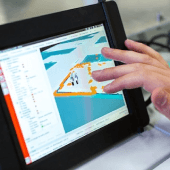Positive Material Identification (PMI)
Exploring New Opportunities With Handheld LIBS
Published on 3rd June 2021

The invention of handheld LIBS has been a game changer to the world of verifying carbon content at remote or inhospitable sites. But this is just the beginning of the portable elemental analysis evolution, with researchers taking the tech to levels that were only imaginable just a few short years ago.
The following looks at some of the most exciting areas currently being
explored.
The Role of LIBS in Forensic Science & Fighting Crime
One of the key elements of LIBS is the analysis of tiny parts. In forensics, the ability to quickly identify fragments will streamline classification of evidence – not to mention the ability of being able to do this in situ, rather than waiting for a lengthy lab examination process.
The impact of such technology will be startling, allowing investigators to quickly identify substances such as:
- · Glass
- · Ink
- · Paper
- · Paint
- · Biological materials
- · Nuclear and radiological
materials
- · Textiles
Having LIBS in the field revolutionised the ability to prove or disprove theories and quickly find conclusive evidence.
The Role of LIBS in Conservation
Having a minimally destructive inspection technique to determine materials within priceless works of art is sci-fi brought to reality. For instance, being able to quickly identify the difference between mahogany wood or a look-a-like in a piece of 18th century furniture without an chance of damage would be of high interest to the field.
The Role of LIBS in Regions of Conflict
Many mines are located in areas where conflict is rife. Militia might control certain mines and then take over more (or lose control of them), leading to an ever-changing playing field. The ability to create a comprehensive library of minerals from verified locations and, therefore, prevent the case being made that a certain sample came from a different location would be invaluable. In such shifting landscapes the more definitive proof available, the better.
The Role of LIBS in Areas of Combat
War-torn regions are littered with spent ammunition. Identifying cartridge cases provides essential evidence, not only about those who were carrying out the fighting, but also about those who supplied the ammunition.
The Role of LIBS in Archaeology
Because LIBS works through plasma formation and light transmission, it can also relate to physical properties of what’s tested. The value of this to test areas, such as seashells, found within archaeological excavations is tremendous. It has the potential to dramatically increase the information archaeologists can gather from finds.
Dr Richard Hark, working as a partner with SciAps – creators of the first handheld LIBS – has been responsible for much of this exciting research into how the technology will be utilised in wide variety of industries. From the analysis of volcanic rocks and gemstones through to wooden structures, logs and even fragments of ancient crockery uncovered in locations around the world, it seems there’s no field that won’t be able to take advantage of such fast-moving tech.
Equipment provider, Nexxis, is at the forefront of providing innovative technological equipment and non-invasive testing kit to industries such as Oil & Gas, Nuclear, Mining, Subsea and more.
To discover more visit Nexxis












